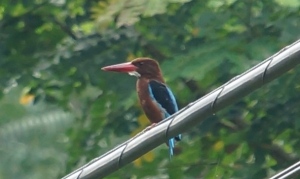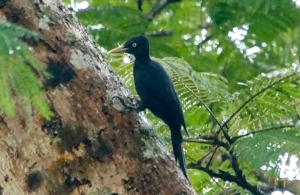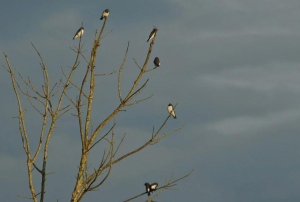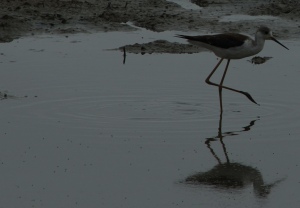The weather was better now than when we last came here, now my bird loving tito, tita and cousin came with us. There were still light rain showers but it would only last for a short while then the rest of the day was sunny and perfect for birding. Subic still had the usual Large-billed Crows and White-breasted Woodswallows, which were sort of as common as Eurasian Tree Sparrows in the area.
The common birds, Yellow-vented Bulbuls, Zebra Doves, Glossy Swiftlets, Pacific Swalows and Brown Shrikes, flew around the residential areas of Subic Homes as we checked-in. If you ever come to Subic, this is the place I suggest you stay because even in Subic Homes a lot of birds can already be found but let me tell you about Subic Homes later on.
Before we talk about the birds in Subic Homes, let’s first talk about the Boton Forest Trail. There were actually not many birds here except Black-naped Orioles, but this was the place I first laid eyes on my first malkoha, the Red-crested Malkoha. It is a Luzon Endemic, and a common resident in the forests of Subic. Later that day, we even found them flying in front of us.

White-throated Kingfisher perched on wire
<Photo by King Pandi>
Well, other than the malkoha it wasn’t really a birdy place, so we drove to the old Bat Kingdom and on our way there we saw a lot of White-throated King-fishers occasionally parching on wires or small trees beside the road. I then saw something brown with some spot-like patterns and I knew it was different. We nearly ignored it, but then I shouted “Wait! Stop the Car!” I was right; it was something else, a Female Blue Rock-Thrush.

Female Blue Rock-Thrush <Photo by King Pandi> Lifer no. 88
At the Bat Kingdom, Me and Tristan (Cousin) saw two species of woodpeckers, happily pecking on these bark-less trees. They were the cut little Philippine Pygmy Woodpecker, and to my surprise a woodpecker we didn’t expect to see, a Greater Flameback. I was a beautiful woodpecker with its red back, and another surprise, we didn’t just see one, but three! A very nice lifer.

Philippine Pygmy Woodpecker <Photo by King Pandi>
I was also finally able to see the Stripe-headed Rhabdornis, which I have been trying to track down ever since I missed it at Mt. Palay-Palay. Then once we were done with the Bat Kingdom, wile driving back to Subic Homes, we saw Philippine Serpent-Eagles, another bird I missed out on in Mt. Palay-Palay, flying in circles which I think i’s called thermaling.
In the afternoon, we planned to go to Hill 394, but sadly we had to have a permit to got there. I guess when WBCP has a Club Trip there, they issue first a permit. We sadly weren’t informed of this, and we didn’t have time to get one, so we had to go with the back-up plan, birding near Zoobic Safari. We saw more or less the same birds, Philippine Bulbuls were here, and so were White-bellied Woodpeckers, and an abundance of Balicassiaos.
Now, let’s go back to Subic Homes. We birded there a bit late, from noon to night then again at early morning and found a Colasisi and a White-collared Kingfisher. There was actually a particular tree there which I really want to know what kind. It surprised me because in this one three we listed the following birds:
- A flock of 10+ Pompadour Green-Pigeons, Lifer

Pompadour Green-pigoen <Photo by King Pandi> Lifer no. 81
- About 3+ Coppersmith Barbets
- Large-billed Crows
- A few Coletos
- Yellow-vented Bulbuls
- Brown Shrikes
- A Blue-naped Parrot
- Balicassiaos, Lifer
- And a flock of 8+ Luzon Tarictic Hornbills

Luzon Tarictic Hornbill <Photo by King Pandi>
What surprised me really was the flock of Hornbills that fly there to feed in the morning and the Pompadour Pigeons that never leave the tree. My Ninang Princess calls it “The Tree of Life”. If anyone could identify this tree for me, hopefully those of the WBCP would know this tree, I would be very grateful.

“Tree of Life” <Photo by King Pandi>
Also, in front of a Brent International School, Subic, which was located in the same area as the Subic Homes residential, was a flock of SEVERAL, about 20 to 30 parrots. The parrots composed of Blue-backed Parrots, Guaiaberos, a single Green Raquet-tail, and the most plentiful were the Blue-naped Parrots. The Guaiabero was my lifer, but I didn’t count the Blue-backed Parrot and the Raquet-tail since I only saw both for barely a second before it flew off.

Blue-naped Parrots <Photo by King Pandi>
In the same area, we also found some strange looking woodpeckers. Some were pure black while others had red faces. They were in fact Sooty Woodpeckers, the all black being females and the rad face being males. We also saw Bar-bellied Cuckoo-shrikes which I had almost mistaken as a Balicassiao, but just my luck, an actual Balicassiao was right beside it and I was able to see the difference.

Sooty Woodpecker <Photo by King Pandi>
Lifer no. 82
In a wetland area near Subic Homes, next to a golf course, we found a Buff-banded Rail. We then saw something HUGE fly across the wetland. It perched on a tree, and if we didn’t see it fly there we would have thought it was a branch since it was really well camouflaged. It was a very huge Purple Heron. It turns out that the Subic Homes Area had the most birds among all the places we went to in Subic.

Purple Heron <Photo by King Pandi>
Lifer no.86
I left Subic with sadness in my heart. I wish I lived there with the birds just outside my window, but my place is here in Metro Manila. A “Maya’s Paradise!” :D. This has been my best birding trip so far, and I can’t wait for the day I would finally come here with the WBCP. When that time comes, it would mean more birds and an access to hill 394.






















